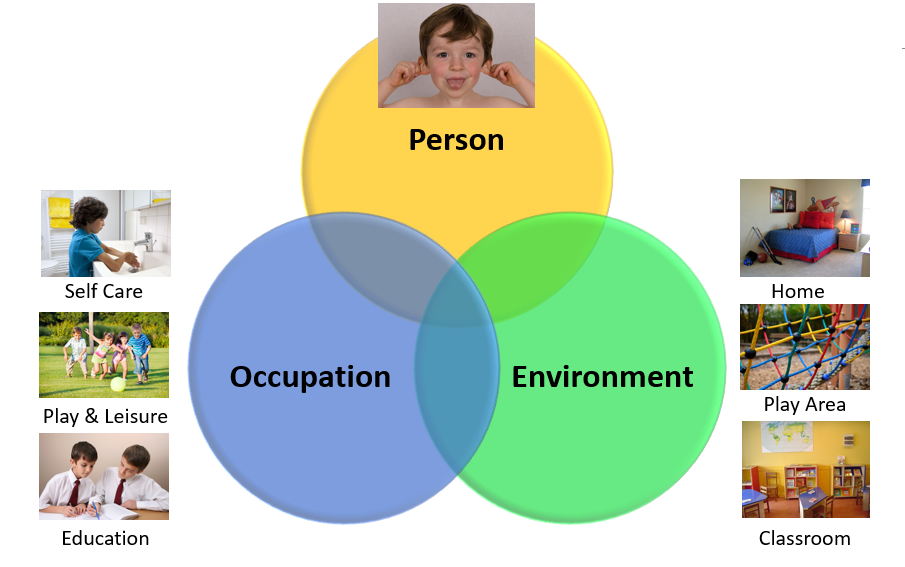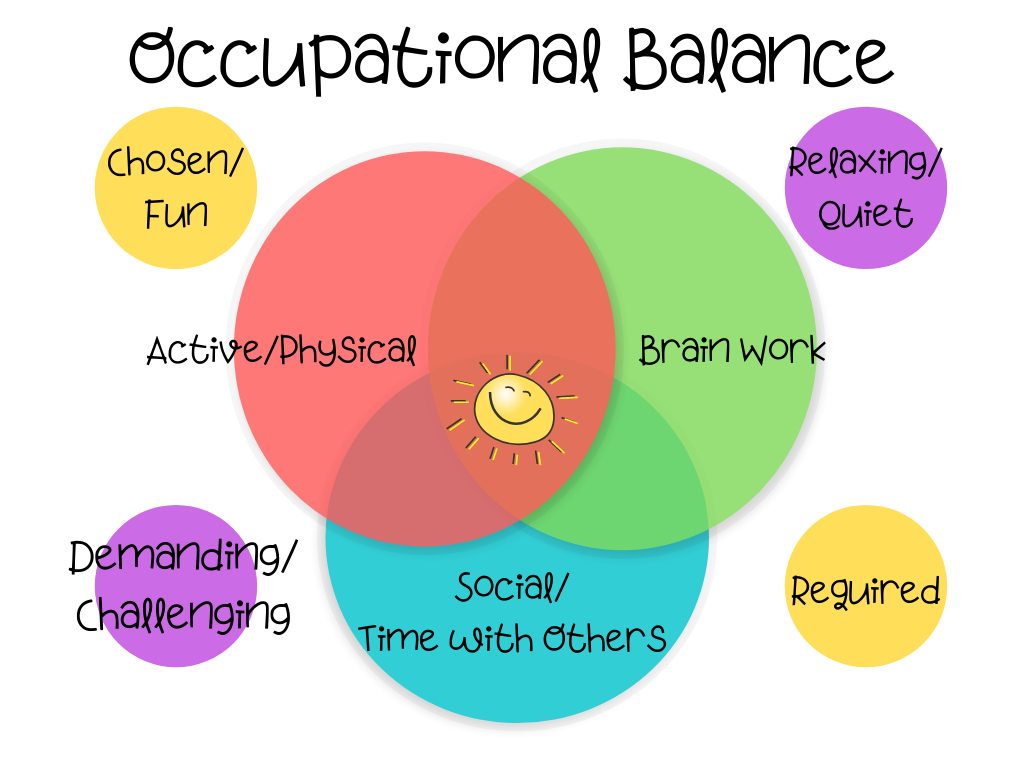
Joining in (participating in) every day activities (occupations) improves wellbeing. Taking part in occupations helps you to live a safe, healthy and happy life.
There is a connection between 'the person', 'the occupation' and 'the environment'. Making changes to any of these areas can improve participation and wellbeing.
No one will ever learn any new skills if they do not join in and practice. Sometimes you need to have a go and make mistakes so that you can learn.

We all have our own beliefs, motivators, learning styles, strengths/resilience and vulnerabilities. These can all impact on participation and wellbeing.

Everyone has their own likes and dislikes. What motivates them to persevere with an activity when it is challenging is different for each individual. For most children play is motivating.
Goal setting can help you to empower your child/young person to make changes in their life. Talking about what is important to you both and agreeing on a shared goal ensures you are both motivated to put in the work required to make the changes needed.
You can use reward charts and keep videos and photos of before and after working on the goal to keep your child motivated. Tell other adults who your child respects so that they can support you both.
Everybody learns in different ways. There are three main ways of learning: doing (kinaesthetic), watching (visual), and listening (auditory). Everyone has their own preference of how they learn best and you and your child may vary in these preferences. You may need to help your child in different ways by showing, telling or physically doing with your child.

Some people need a combination of information to learn best and others cannot cope with a combination of information. Experiment with each of these learning styles and find what suits your child best. Remember that some children cannot listen and look at the same time so you might need to show your child and then tell your child rather than showing and telling at the same time.
No one will ever learn any new skills if they don't take part and practice. Sometimes you need to have a go and make mistakes so that you can learn. It is important that children and young people are supported to join in with everyday activities from an early age. This gives them the best chance of reaching their potential and becoming independent adults.

Some children/young people will always need others help for some or all of their occupations and practice will not help them to develop skills. Taking part is also important for these children/young people as being involved in their own care to the best of their abilities can have a huge impact on their well-being.
 There are lots of ways that you can think about making changes to the occupation or task.
There are lots of ways that you can think about making changes to the occupation or task.
 Think about when you are trying to learn a new skill. If the task is too easy it doesn’t pose a challenge and you get bored quickly. If the task is too challenging then you become frustrated and may give up.
Think about when you are trying to learn a new skill. If the task is too easy it doesn’t pose a challenge and you get bored quickly. If the task is too challenging then you become frustrated and may give up.
The same is true for children. We need to give each child the ‘just right’ challenge, not too easy or too hard. Both the principles below can help you to get the challenge ‘just right’ for your child. You can also make the activity easier or harder.
When teaching your child a new skill (e.g. using a fork, tying their laces, making a cup of tea, skipping with a rope, using scissors etc.) it helps to break the activity down into manageable chunks. You can then teach one chunk at a time, make up a visual aid using photographs or symbols or make a sequence checklist depending on what suits your child, or use adaptive equipment to help with a specific step. You can also look at each of the steps in turn to identify where things are going wrong for your child/young person.
Think about making a cup of tea, this activity can be broken down into lots of different steps. The steps may vary given the environment, what order you like to do things in (milk first or last?) but generally they remain the same. Once you have learned the key components of a task, you then learn how to do the task in different environments.
Let’s break making a cup of tea down into steps.
 Place the tea bag in the mug/teapot.
Place the tea bag in the mug/teapot.Here are some examples of how you can use these steps to help your child to learn a new skills.
Use photos or symbols to aid learning.

Use checklists as reminders of the sequence of steps.
These could be written lists with boxes to tick when steps are completed. Or you could combine the checklist with photos or symbols.

Focus on teaching one step at a time.
Use adaptive/alternative equipment for the different steps.
In the making tea example you could use:

There are different methods you can use to help your child to learn.
You can show your child, do the activity next to them or watch videos of the task. The child is watching.
You can tell your child, talk your child through each step of the process. The child is listening.

Try out different ways of helping until you find what suits your child. You can use each of these ways individually or any combination depending on what suits your child. For a lot of children it can be difficult to watch and listen at the same time. So try each way individually before you try using combinations. Once you find what works for your child stick with this approach.
The environment can impact on participation and well-being.

To support participation in occupation you can make changes to the environment. You can think of the environment in a variety of ways such as physical, sensory. Social and cultural.
Think about the physical environment. Changing where a task is complete can make it easier for your child/young person. For example it might be better for your child to get dressed in the bedroom or bathroom. Also think about the position your child/young person uses to complete the task. It might be easier to sit down when tying laces for example.
The sensory environment can impact on a child/young person's participation and well-being. Some children and young people can find a sensory environment overwhelming. By changing with sensory environment you can help your child/young person to join in. For more information visit the Joining in with Sensory Differences page.
Think about the social and cultural environment your child or young person is part of. Are these environments helping or making it harder for your child to succeed?
Having a routine can help with lots of different things, like sleep and managing your emotions. It helps to do a variety of different activities through the day. So get up, eat meals and go to bed at the same time every day, even at the weekends! Do what works for you.
Below are some ideas, activities and resources to help you build a routine.
There are lots of options you can use to plan out your day and to help you stick to that plan. You can use technology or a diary/notebook/planner to help with this.
You could use a diary or notebook to organise your days or use the Daily Planner Printable below.

 Technology can be useful too. Most phones have alarms and calendars you can use to help you stick to your routine. Setting alarms and reminders can help to keep you on track throughout the day. Try setting one for getting up, one for mealtimes and one for wind down time before bed.
Technology can be useful too. Most phones have alarms and calendars you can use to help you stick to your routine. Setting alarms and reminders can help to keep you on track throughout the day. Try setting one for getting up, one for mealtimes and one for wind down time before bed.
There are also other apps out there that might help. Remember to check out the reviews and security before installing them. Do not share your personal information with anyone. You might want to share what you are using with your family so that they can help you to manage your routine.
It is important to do a bit of what you love every day. That doesn't mean you should play computer games or be on social media all day. Doing a little bit of what you love is always good for you. You need a balance of activities throughout the day. You need something active, something quiet and relaxing, something to make your brain work and something with other people. You also need a balance between things you have to do (school work, brushing your teeth, eating ...) and things you want to do.
